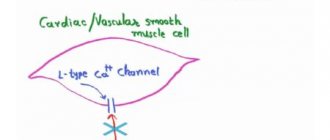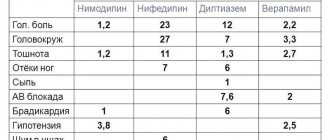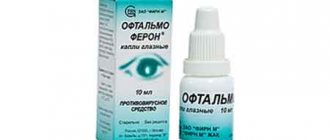Instructions for use of "Amlodipine"
In the membranes of smooth muscle cells of arteries, cardiomyocytes, sinus and atrioventricular nodes, there are voltage-dependent slow Ca2+ channels of L- and T-type. Amlodipine slows down the transport of calcium ions into the cytoplasm, preventing the interaction of the contractile proteins actin and myosin.
The drug belongs to the subgroup of dihydropyridine antagonists, which have a vasodilator effect without changing myocardial contractility and sinus node automatism. Therefore, Amlodipine is considered a vasoselective representative of the class.
Main effects of the drug:
- Antihypertensive. The drug acts primarily on the smooth muscles of peripheral arterioles of medium and small caliber. Blockade of calcium entry into the cytoplasm causes cell relaxation, the lumen expands, and overall vascular resistance and afterload on the heart muscle decrease.
- Antianginal.
Dilatation of coronary vessels and prevention of repeated spasm ensures adequate blood supply to the working myocardium. Additionally, oxygen consumption is reduced when the afterload on the left side of the heart is corrected, and muscle relaxation in diastole (the phase of blood filling of the coronary vessels) is optimized. Taking Amlodipine by patients with coronary artery disease (CHD) prolongs the period of physical activity until the appearance of chest pain and changes in the ECG. The drug reduces the number of attacks and the need to take Nitroglycerin tablets. - Improvement of microcirculation in the kidneys (regulation of renin production), as a result of which one of the links of arterial hypertension is blocked. Renal vascular resistance decreases, glomerular filtration and plasma flow increase.
- Increases cerebral circulation, prevents ischemic damage (stroke).
- Reducing blood viscosity, inhibiting platelet aggregation, increasing the fibrinolytic ability of plasma. Improving rheological properties has a positive effect on systemic hemodynamics, especially in patients with a long history of coronary heart disease.
- Antiatherogenic effect. Amlodipine prevents the penetration of low-density lipoproteins into endothelial cell membranes, preventing damage to the vascular wall.
- Stimulation of the release of nitric oxide from the vascular endothelium.
For long-acting antihypertensive medications, the main criterion for effectiveness is the ability to “overlap” the 24-hour period, prolonging the effect until the next dose of the drug. The half-life of Amlodipine exceeds 35 hours.
The drug has the most consistently high bioavailability in comparison with other representatives of the class (65-70%). Due to the slow increase in peak concentration in tissues and long-term elimination, a stable blood pressure curve is ensured throughout the day.
Indications: what does it help with and at what pressure is it prescribed?
The drug "Amlodipine" is optimally suited for long-term treatment regimens for chronic conditions. The main groups of indications are presented in the table.
| Disease | Peculiarities |
| Hypertension (HD) |
|
| Coronary heart disease |
|
| Concomitant pathologies associated with ischemic heart disease or hypertension |
|
Amlodipine is suitable for the treatment of hypertension in pregnant women, dark-skinned patients and children over 6 years of age.
Calcium antagonists have a relaxing effect on the muscles of the uterus, which must be taken into account when prescribing the drug in the last weeks of pregnancy.
Directions for use and dosage: how to take?
Taking Amlodipine does not depend on the time of day or diet. The recommended starting dose of saturation is 5 mg 1 time per day. The correction is carried out depending on the patient’s sensitivity to therapy and blood pressure levels. The dosage regimen is assessed and adjusted 14 days from the start of the course.
Con (active metabolic products) in tissues is stabilized after 7 days of systematic use. Due to the smooth increase in the hypotensive effect, there is no risk of reflex acceleration of the pulse or addiction during long-term treatment.
Amlodipine is used for basic monotherapy and in combination with anti-ischemic drugs of other classes for patients suffering from coronary artery disease.
Simultaneous treatment with several antihypertensive drugs does not require revision of the dosage of Amlodipine.
The medicine is used for hypertension in children over 6 years of age. Recommended regimen: starting dose - 2.5 mg/day, if the hypotensive effect is insufficient - correction after 28 days (up to 5 mg/day).
For patients with renal or hepatic insufficiency, elderly people - increasing the dose of the drug is allowed with constant monitoring of hemodynamics.
Sharp restriction or cessation of taking the drug does not cause withdrawal symptoms.
Special instructions and symptoms of overdose
Amlodipine is a widely used drug, so it is necessary to use safe combinations with:
- diuretics ("Hydrochlorothiazide")
- adrenergic receptor blockers (Metoprolol, Bisoprolol and others);
- ACE inhibitors (Ramipril, Lisinopril);
- long-acting nitrates (“Sustak”, “Nitrosorbitol”).
Simultaneous administration of Amlodipine and high doses of Simvastatin contribute to disruption of the metabolism of the latter. The maximum amount of lipid-lowering medication should be limited to 20 mg.
Concomitant use of alcohol with Amlodipine does not affect the rate of ethanol metabolism. International clinical protocols for the treatment of cardiovascular pathologies recommend limiting the amount of alcohol for patients with hypertension or coronary artery disease.
In the first weeks of therapy, the drug affects the ability to drive vehicles and operate complex machinery. A decrease in the severity of the reaction is accompanied by migraines, dizziness and attacks of nausea. At the initial stage of treatment, it is recommended to limit these types of activities.
In case of poisoning with Amlodipine, a drop in tone and dilation of peripheral vessels occurs, which is accompanied by tachycardia, dizziness, collapse (severe arterial hypotension).
Treatment of overdose of Amlodipine:
- gastric lavage;
- administration of drugs that constrict blood vessels;
- infusion of a solution of glucose with calcium;
- constant monitoring of cardiac parameters, central venous pressure, diuresis;
- drug correction of emerging disorders.
"Amlodipine" has strong connections with plasma globulins, so the use of dialysis is ineffective.
Contraindications
The use of Amlodipine is not recommended for the following conditions:
- intolerance to dihydropyridine or other components;
- severe arterial hypotension;
- states of shock;
- obstruction of the left ventricular outflow tract (critical aortic valve stenosis);
- unstable hemodynamic condition for 14 days in patients who have suffered a myocardial infarction;
- progressive angina;
- systolic dysfunction of the left heart (EF less than 40%);
- lines of pregnancy up to 12 weeks.
Side effects
Undesirable effects during treatment with Amlodipine are rare, the main symptoms of which are indicated in the table.
| Frequent reactions |
|
| Rare side effects |
|
Amlodipine overdose
In case of an overdose of Amlodipine, the patient exhibits the following alarming clinical signs:
- Reducing blood pressure to critical levels;
- Increased peripheral vasodilation;
- Tachycardia (rapid heartbeat);
- Arrhythmia (irregular heart rhythm).
Treatment begins with gastric lavage and inducing artificial vomiting in the person. After this, the patient is prescribed sorbents and drugs to maintain the heart and blood vessels.
To restore vascular tone, vasoconstrictors and calcium gluconate may be indicated.
Therapy is carried out in a hospital setting under the supervision of specialists who constantly monitor changes in the patient’s condition.
Amlodipine analogues: what to replace the drug with?
The manufacturer of the original drug called “Norvasc” (pharmaceutical company Pfizer, USA) produces the drug in dosages of 5 and 10 mg.
Generics are medicines with identical amounts of active ingredients, but at a lower cost. The high price of the original drug, high demand due to the frequent prescription of medications of this group are the main reasons for the appearance of domestic and imported analogues on the Russian market:
- "Amlodipine" Russia;
- "Agen", "Tengisal" Czech Republic;
- “Azomex”, “Amlovas”, “Amlogen”, “Vazodipine” India;
- Amlo-Sandoz Poland/Slovenia;
- Amlodipine-Pfizer Germany;
- "Amlocard-Sanovel", "Norvadin" Türkiye;
- "Amlocor" Bulgaria;
- "Amlodipine-Zentiva" Israel;
- "Normodipin", "Emlodin" Hungary;
- "Tenox" Slovenia.
Drug substitutes are drugs with a similar pharmacodynamic effect and a list of indications due to the influence of another active ingredient. The main substitutes for Amlodipine are representatives of other classes of calcium channel blockers:
- "Nifedipine" ("Corinfar", "Kordipin", "Osmo-Adalat");
- "Lecardipine" ("Lerkamen");
- "Felogexal" Germany;
- "Nitresal" Czech Republic;
- "Nimodipine."
The pharmaceutical market offers combination drugs of Amlodipine with other antihypertensive drugs. Taking a substitute without consulting a doctor is strictly prohibited. Different active ingredients differ in the spectrum and severity of their effects, and their compatibility with medications taken.
Interaction with other drugs
When combined with non-steroidal anti-inflammatory drugs, estrogens, sympathomimetics, adrenostimulants, the hypotensive effect of the blood pressure drug Amlodipine is significantly reduced.
It is not recommended to take tablets together with lithium preparations due to the possible increase in toxic effects on the patient's body.
The hypotensive effect of the drug increases in combination with beta-blockers, diuretics, nitrates, and ACE inhibitors. This must be taken into account when determining the optimal dosage of Amlodipine tablets in order to prevent possible adverse reactions and too strong a decrease in blood pressure.
conclusions
A single use of Amlodipine by patients with arterial hypertension provides a stable reduction in blood pressure for 24 hours. Due to the smooth increase in the pharmacological effect, there are no symptoms of acute hypotension.
Pleiotropic (multidirectional) action "Amlodipine" controls the course of diseases that often accompany hypertension - diabetes mellitus, metabolic syndrome, atherosclerosis, obstructive pulmonary pathology and gout.
Before using Amlodipine, you should consult your doctor and carefully study the instructions.
Important Notes
During the therapeutic course with the drug Amlodipine, it is necessary to monitor the patient's salt intake and body weight. To achieve the most pronounced positive result, a salt-free diet may be recommended.
A salt-free diet is recommended while taking the drug.
Increased attention should be paid to the condition of teeth and oral hygiene, and during long-term treatment, undergo preventive dental examinations. This is explained by the fact that Amlodipine tablets can provoke the development of hyperplasia, pain and bleeding of the gums.
Despite the absence of withdrawal symptoms, doctors recommend reducing the dosage of the drug smoothly and gradually. Otherwise, there is a possibility of the following unpleasant symptoms:
- Nausea;
- Tremor;
- Excessively intense sweating;
- Sleep disturbance;
- Sudden mood swings;
- Diarrhea.
The clinical signs listed above may occur in the first days after discontinuation of the drug and disappear on their own within 2 weeks.
There are no exact data regarding the effect of Amlodipine tablets on the central nervous system, reaction speed and ability to concentrate. For this reason, experts recommend refraining from driving vehicles and other complex activities, at least in the first days of the therapeutic course.
Consumer Reviews
Among the reviews from patients who took Amlodipine, there are mostly positive statements:
“The doctor prescribed me Amlodipine at 34 weeks, my blood pressure jumped, and my legs were very swollen. In the first two days there was no particular effect, then the pressure began to normalize. At first they prescribed 5 mg, then switched to 10 mg.”
Women who took the drug while breastfeeding also responded positively:
“During pregnancy I had high blood pressure, because of this I was prescribed Amlodipine and Atenolol. The pressure began to gradually decrease. She gave birth without any problems, then decided to go to the therapist, as her blood pressure began to rise again. The doctor allowed me to take medications, although I was breastfeeding. She explained this by saying that lactation is not an absolute contraindication, but only a relative one.”
“Pregnant women, as well as those planning a pregnancy, can take Dopegit or Concor (only up to 38 weeks). You can also take Amlodipine - it was prescribed to me. I have suffered from high blood pressure since adolescence, which worsened during pregnancy. The pressure began to rise after 20 weeks. The drug personally helped me well,” says a patient who took the drug Amlodipine. Timely and effective treatment of arterial hypertension during pregnancy is the best prevention of perinatal complications for both the woman and the fetus.
Today, preference is given to drugs that can not only correct blood pressure, but also have a protective effect on organs. Amlodipine is recognized as one of these drugs - a simple and well-tolerated remedy.
This educational video will tell you more about high blood pressure:
See also:
- Trigun instructions
- Nebilet's instructions for arterial hypertension
- Medicines during pregnancy
- Instructions for use of Mildronate
- Instructions for use 5-NOK
- Raunatin's instructions
- Mirlox instructions and features of taking the drug
- Reviews of Rovamycin (antibiotic)
- Cordaflex for the treatment of cardiovascular diseases
(No Ratings Yet)
About the author: Sofia Tutovsky
« Previous entry
Indications for use
Amlodipine is prescribed in the following cases:
- Normalization of blood pressure
- Treatment of high blood pressure
- Treatment of myocardial ischemia caused by persistent angina or coronary artery spasms
The medicine can also be used if the clinical picture indicates the possible presence of a vasospastic component.
Amlodipine can be taken alone or in combination with other drugs in this group if angina pectoris is not treatable with other medications.
Side effects
During therapy with Amlodipine, side effects from various body systems may occur. These include:
- rapid heartbeat, peripheral edema, orthostatic hypotension, vasculitis, bradycardia, tachycardia, atrial fibrillation, myocardial infarction, migraine, chest pain;
- headache, dizziness, fatigue, malaise, fainting, asthenia, paresthesia, hypoesthesia, neuropathy, tremor, convulsions, apathy, amnesia, ataxia, agitation, depression;
- blurred vision, diplopia, spasm of accommodation, conjunctivitis;
- thrombocytopenia, purpura, leukopenia;
- shortness of breath, rhinitis, cough;
- nausea, abdominal pain, vomiting, flatulence, constipation, diarrhea, dyspepsia, anorexia, thirst, taste disturbances, dry mouth, gum hyperplasia, increased appetite, pancreatitis, gastritis, jaundice, hepatitis;
- pollakiuria, pain when urinating, dysuria, nocturia, polyuria;
- gynecomastia, impotence;
- myasthenia gravis, back pain, arthralgia, myalgia, arthrosis, convulsions;
- increased sweating, cold sweat, alopecia, xeroderma, skin pigmentation disorders, dermatitis;
- allergies, rash, itching, urticaria, erythema, angioedema;
- tinnitus;
- chills;
- weight gain;
- nose bleed;
- parosmia;
- hyperglycemia.
TREATMENT OF HYPERTENSION IN BRADYCARDIA AND CARDIAC ARRHYTHMIA
Sincerely, Alexander Yurievich.
Mobile phone: +38 (066) 194-83-81 +38 (096) 909-87-96 +38 (093) 364-12-75
Viber, WhatsApp and Telegram: +380661948381 SKYPE: internist55 EMAIL: [email protected]
This was not an advertisement, but a signature for my consultation. I don't advertise and don't need it. I don’t invite anyone to an appointment. I have enough work! But if you have any questions, call or Skype!
Do not be shy. I will help with all I can!
Contraindications
Amlodipine for high blood pressure is prescribed with caution to patients with impaired liver function, severe bradycardia or tachycardia, chronic non-ischemic heart failure, aortic or mitral stenosis, hypertrophic obstructive cardiomyopathy, acute myocardial infarction. Contraindications for the use of tablets are:
- severe arterial hypotension;
- collapse, cardiogenic shock;
- unstable angina;
- severe arterial stenosis;
- lactose intolerance, lactase deficiency, glucose-galactose malabsorption syndrome;
- pregnancy, lactation (breastfeeding);
- age under 18 years;
- hypersensitivity to dihydropyridine derivatives.
Compound
Amlodipine for blood pressure is available only in tablet format. Their composition indicating the main and auxiliary substances:
| Description | White flat-cylindrical tablets |
| Concentration of amlodipine besilate, mg per piece. | 5 or 10 |
| Supporting cast | Microcrystalline cellulose, calcium stearate, magnesium stearate, lactose, potato starch |
| Package | Blister packs of 10 or 30 pcs., 1, 2, 3, 4, 6 or 9 packs per pack |
Price
The drug can only be purchased with a prescription. The product is stored in a dry, dark place at temperatures up to 25 degrees for three years from the date of manufacture. The drug can be bought in an online store or ordered through a pharmacy catalog. The approximate cost of tablets in Moscow will be:
| Type of packaging (number of tablets in a pack, concentration of active substance) | Manufacturer | Internet price tag, rubles | Pharmacy cost, rubles |
| 5 mg 20 pcs. | Hemofarm | 110 | 119 |
| Vertex | 62 | 65 | |
| 5 mg 30 pcs. | 72 | 79 | |
| Teva | 103 | 110 | |
| Zentiva | 136 | 147 | |
| Sandoz | 124 | 140 | |
| Canonpharma | 93 | 104 | |
| 5 mg 90 pcs. | 145 | 159 | |
| 5 mg 60 pcs. | 101 | 114 | |
| Vertex | 110 | 119 | |
| 10 mg 30 pcs. | 90 | 99 | |
| Canonpharma | 114 | 125 | |
| Sandoz | 277 | 290 | |
| Teva | 147 | 159 | |
| 10 mg 60 pcs. | Vertex | 144 | 158 |
| Canonpharma | 150 | 167 | |
| 10 mg 90 pcs. | 172 | 199 | |
| 10 mg 20 pcs. | Hemofarm | 157 | 169 |
| Vertex | 78 | 89 |









